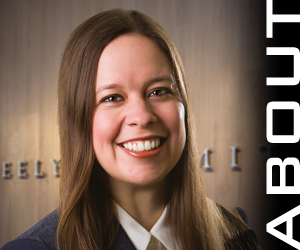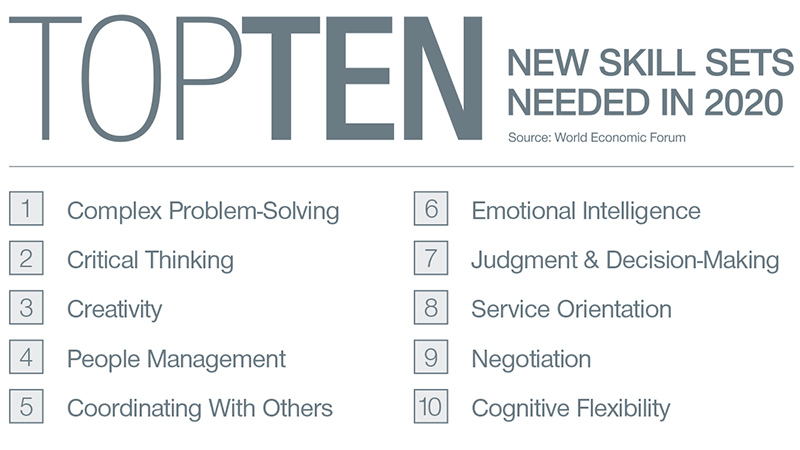Ethics Engaged | Summer 2018
Ethics in the Age of AI
Putting your human ethics and creativity to use in critical thinking and complex problem-solving.

Elizabeth Pittelkow Kittner
CFO and Managing Director, Leelyn Smith LLC
Exploring Ethics in Business & Finance Today
Each day we hear more about how artificial intelligence (AI), automation, blockchain, and
the likes will change the future of accounting and finance. We are told that as accounting
and finance professionals, we need to embrace new technology and learn to adapt to stay
relevant in the future.
AI will be an increasing larger presence in our world, but it cannot compete with the
analytical, emotional, or ethical skills that a human brings to the professional world. Take
a look at the World Economic Forum’s “Future of Jobs” report that predicts the top 10 skill
sets needed to thrive in 2020:

Consider just the top three skills alone — complex problem-solving, critical thinking, and
creativity — and how they apply to the accounting and finance profession. You can read
the skills as a sentence: We will need creativity in critical thinking to help us with complex
problem-solving.
In accounting, it can feel like we spend more time gathering data instead of interpreting
data. When deadlines are tight, it is easy to embrace the attitude of “good enough” once
the data is recorded. We move from project to project, focusing more on quantity and
quickness instead of quality and questioning how the data can make business better for
our companies and clients.
As AI and automation help us work through projects faster, we should refocus our time on
critically thinking through data in creative ways to help solve problems and make processes
better. For example, if you are stressed closing the books every month, you could be setting
aside data analysis that would help you understand the reasons why the financials are the
way they are instead of just what they are.
How do our ethics play into creativity, critical thinking, and complex problem-solving?
You should always approach these activities with a solid ethical framework:
1. Determine your values. What do you care about (e.g. people, innovation, quality, etc.)
and how does it align with the missions of your organization and clients? Ask why you
are doing something.
2. Define your objectives. Ask what it is you are trying to achieve.
3. Develop your plan. Ask how you can achieve your objectives.
This step is where creative critical thinking for complex problem-solving
comes in.
4. Direct your plan. Ask who can help you carry out your plan in
the right way.
5. Debrief. Ask what happened because of your plan. This step is
commonly skipped because it involves analyzing the outcomes
of an action, and many people want to jump to the next
project. Reflection is vital to learning what went well and what
needs improvement.
Throughout the ethical framework, discuss each step with others.
Ethical behavior is strongest when accountability exists. Gathering
different perspectives will encourage critical thinking and facilitate
more creative solutions.
Again, you must ensure you have enough time to think critically,
complete your work, and make decisions. Research suggests that
people justify shortcuts to meet deadlines. The next time you have
a short amount of time to close the books, finish tax returns, or
complete a consulting project, consider the quality of your work.
If you are concerned about quality, ask for more time and explain
your reasons. Give yourself and your team members more time
to act ethically.
Also, understand the environment in which you are making
decisions. Ethical priming is the idea that our behaviors are
influenced by unconscious clues in our environment. The New
York Times article, “Our Inconsistent Ethical Instincts,” states: “Our
moods can make misdeeds seem more or less sinful. Ethical
violations become less offensive after people watch a humor
program like ‘Saturday Night Live.’ But they become more offensive
after reading emotional stories like in ‘Chicken Soup for the Soul.’”
The point of knowing the environment around you is that it
matters, and you shape what the environment is for yourself and
others around you.
Finally, with enough time and the right mindset, creativity can
follow. As mentioned above, talking to others will help generate
more creative solutions, and there are other creativity boosters you
can try. Here are three easy ones:
1. Look at something green. “Our brains associate the color
green — which is so prevalent in nature — with growth and
development. And simply thinking about growth has been
shown to spur our desire for self-improvement and mastering
tasks,” says Stephanie Lichtenfeld, Ph.D., in a study by the
University of Munich.
2. Go for a walk. Our brains need breaks. If you try to force
creativity, your brain may get frustrated with the task. Exercise
stimulates creativity because our brains are more wired for
movement than for language.
3. Keep a journal. Draw, write, or do both. Drawing activates
different parts of your brain than when you think or speak, which
will help your brain be more receptive to new thoughts and
ideas. Writing gets your ideas out of your head, which you can
revisit later. Do you think it is easier to write down ethical
solutions or unethical ones to revisit? I trust you agree that
it is easier to write down ethical thoughts, and in that case,
writing gives you some accountability in your critical thinking
and problem-solving.
Technical skills will always be important in our profession and we
should continue to hone them, but what will continue to separate
us from automation and AI — and even other professions — is our
ability to complement our technical skills with real, human ethical
behaviors and strategic soft skills.